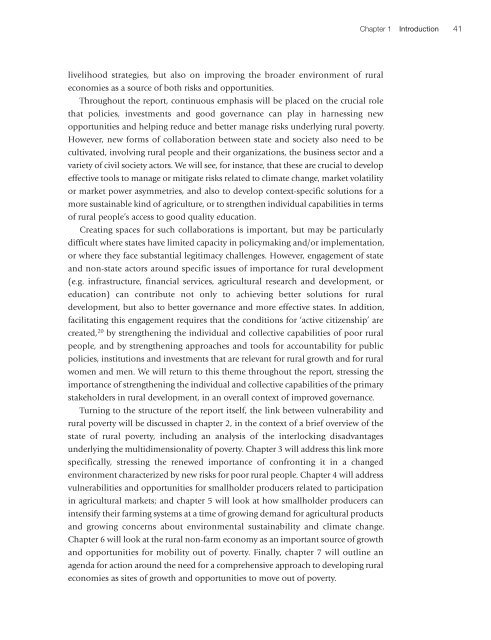English - IFAD
English - IFAD
English - IFAD
You also want an ePaper? Increase the reach of your titles
YUMPU automatically turns print PDFs into web optimized ePapers that Google loves.
Chapter 1 Introduction 41<br />
livelihood strategies, but also on improving the broader environment of rural<br />
economies as a source of both risks and opportunities.<br />
Throughout the report, continuous emphasis will be placed on the crucial role<br />
that policies, investments and good governance can play in harnessing new<br />
opportunities and helping reduce and better manage risks underlying rural poverty.<br />
However, new forms of collaboration between state and society also need to be<br />
cultivated, involving rural people and their organizations, the business sector and a<br />
variety of civil society actors. We will see, for instance, that these are crucial to develop<br />
effective tools to manage or mitigate risks related to climate change, market volatility<br />
or market power asymmetries, and also to develop context-specific solutions for a<br />
more sustainable kind of agriculture, or to strengthen individual capabilities in terms<br />
of rural people’s access to good quality education.<br />
Creating spaces for such collaborations is important, but may be particularly<br />
difficult where states have limited capacity in policymaking and/or implementation,<br />
or where they face substantial legitimacy challenges. However, engagement of state<br />
and non-state actors around specific issues of importance for rural development<br />
(e.g. infrastructure, financial services, agricultural research and development, or<br />
education) can contribute not only to achieving better solutions for rural<br />
development, but also to better governance and more effective states. In addition,<br />
facilitating this engagement requires that the conditions for ‘active citizenship’ are<br />
created, 20 by strengthening the individual and collective capabilities of poor rural<br />
people, and by strengthening approaches and tools for accountability for public<br />
policies, institutions and investments that are relevant for rural growth and for rural<br />
women and men. We will return to this theme throughout the report, stressing the<br />
importance of strengthening the individual and collective capabilities of the primary<br />
stakeholders in rural development, in an overall context of improved governance.<br />
Turning to the structure of the report itself, the link between vulnerability and<br />
rural poverty will be discussed in chapter 2, in the context of a brief overview of the<br />
state of rural poverty, including an analysis of the interlocking disadvantages<br />
underlying the multidimensionality of poverty. Chapter 3 will address this link more<br />
specifically, stressing the renewed importance of confronting it in a changed<br />
environment characterized by new risks for poor rural people. Chapter 4 will address<br />
vulnerabilities and opportunities for smallholder producers related to participation<br />
in agricultural markets; and chapter 5 will look at how smallholder producers can<br />
intensify their farming systems at a time of growing demand for agricultural products<br />
and growing concerns about environmental sustainability and climate change.<br />
Chapter 6 will look at the rural non-farm economy as an important source of growth<br />
and opportunities for mobility out of poverty. Finally, chapter 7 will outline an<br />
agenda for action around the need for a comprehensive approach to developing rural<br />
economies as sites of growth and opportunities to move out of poverty.

















